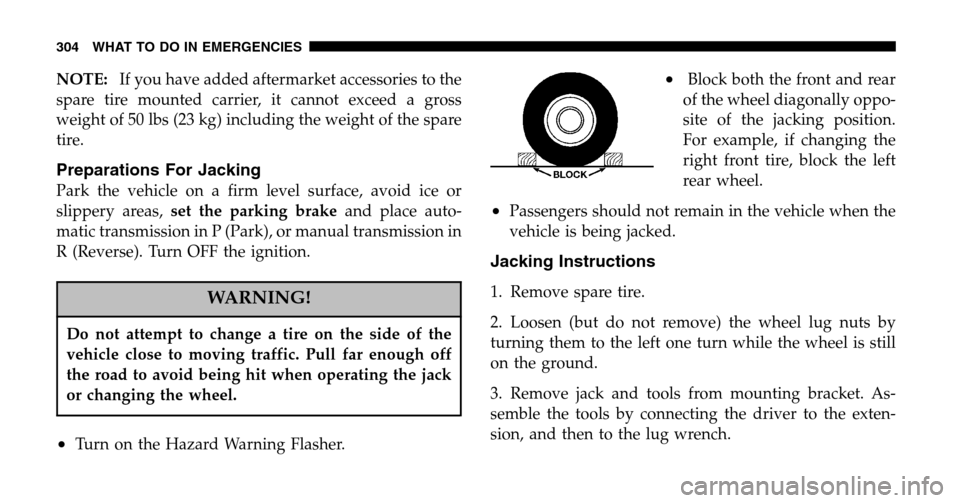Page 304 of 424

NOTE:If you have added aftermarket accessories to the
spare tire mounted carrier, it cannot exceed a gross
weight of 50 lbs (23 kg) including the weight of the spare
tire.
Preparations For Jacking
Park the vehicle on a firm level surface, avoid ice or
slippery areas, set the parking brake and place auto-
matic transmission in P (Park), or manual transmission in
R (Reverse). Turn OFF the ignition.
WARNING!
Do not attempt to change a tire on the side of the
vehicle close to moving traffic. Pull far enough off
the road to avoid being hit when operating the jack
or changing the wheel.
•Turn on the Hazard Warning Flasher.
•Block both the front and rear
of the wheel diagonally oppo-
site of the jacking position.
For example, if changing the
right front tire, block the left
rear wheel.
•Passengers should not remain in the vehicle when the
vehicle is being jacked.
Jacking Instructions
1. Remove spare tire.
2. Loosen (but do not remove) the wheel lug nuts by
turning them to the left one turn while the wheel is still
on the ground.
3. Remove jack and tools from mounting bracket. As-
semble the tools by connecting the driver to the exten-
sion, and then to the lug wrench.
304 WHAT TO DO IN EMERGENCIES
Page 307 of 424

JUMP STARTING — GASOLINE ENGINES
NOTE:Check the charge indicator on the battery. If the
indicator is light or yellow, replace the battery.
1. Wear eye protection and remove any metal jewelry
such as watch bands or bracelets that might make an
unintended electrical contact.
2. When boost is provided by a battery in another
vehicle, park that vehicle within booster cable reach but
without letting the vehicles touch. Set the parking brake,
place the automatic transmission in P (Park), or manual
transmission in N (Neutral), and turn the ignition to OFF
for both vehicles.
3. Turn off the heater, radio and all unnecessary electrical
loads. 4. Connect one end of a jumper cable to the positive
terminal of the discharged battery. Connect the other end
of the same cable to the positive terminal of the booster
battery.
5. Connect the other cable, first to the negative terminal
of the booster battery and then connect the other end to
a non-paint metal surface on the engine of the vehicle
with the discharged battery. Make sure you have a good
contact on the engine.
6. Start the engine in the vehicle which has the booster
battery, let the engine idle a few minutes, then start the
engine in the vehicle with the discharged battery.
7. When removing the jumper cables, reverse the above
sequence exactly. Be careful of the moving belts and fan.
WHAT TO DO IN EMERGENCIES 307
6
Page 312 of 424

▫Driveline And Steering Component
Lubrication ..........................329
▫ Body Lubrication .....................329
▫ Windshield Wiper Blades ................330
▫ Windshield Washers ...................330
▫ Exhaust System ......................331
▫ Cooling System .......................332
▫ Hoses And Vacuum/Vapor Harnesses .......337
▫ Brake System ........................337
▫ Automatic Transmission ................340
▫ Hydraulic Clutch Fluid —
Manual Transmission ..................342
▫ Manual Transmission ..................342
▫ Transfer Case ........................342 ▫
Front/Rear Axle Fluid ..................343
▫ Appearance Care And Protection From
Corrosion ...........................345
� Fuse Panel ...........................349
▫ Interior Fuses ........................349
▫ Underhood Fuses
(Power Distribution Center) ..............351
� Vehicle Storage ........................355
� Replacement Bulbs ......................356
� Bulb Replacement ......................356
▫ Head Light ..........................356
▫ Front Turn Signal .....................357
▫ Front Fog Light (Front Fascia Mounted) .....358
▫ Light Bar ...........................359
312 MAINTAINING YOUR VEHICLE
Page 342 of 424

Hydraulic Clutch Fluid — Manual Transmission
The clutch hydraulic system is a sealed maintenance free
system. In the event of leakage or other malfunction, the
system must be replaced.
Manual Transmission
Selection of Lubricant
Use only manufacturer’s recommended manual trans-
mission fluid, refer to Fluids, Lubricants, and Genuine
Parts for correct fluid type.
Fluid Level Check
Check the fluid level by removing the fill plug. The fluid
level should be between the bottom of the fill hole and a
point not more than 3/16” (4.76 mm) below the bottom of
the hole.
Add fluid, if necessary, to maintain the proper level.
Frequency of Fluid Change
Under normal operating conditions, the fluid installed at
the factory will give satisfactory lubrication for the life of
the vehicle. Fluid changes are not necessary unless the
lubricant has become contaminated with water. If con-
taminated with water, the fluid should be changed im-
mediately.
Transfer Case
Fluid Level Check
Inspect the transfer case for fluid leaks. If a fluid leak is
evident, the transfer case fluid level can be checked by
removing the fill plug (B) located at the back of the
transfer case.
The fluid level should be to the bottom edge of the fill
hole (A) when the vehicle is in a level position.
342 MAINTAINING YOUR VEHICLE
Page 351 of 424

Cavity Fuse Description
34 15 Amp Blue Body Control Module/ Cluster/Interior Lights,
Hands Free Module/Radio/
CMTC/ITM Module & Siren
(Export Only)
35 Spare
36 10 Amp Red Airbag Control Module/ Occupation Classification
Module (Right Front Seat)
37 10 Amp Red Airbag Control Module
38 10 Amp Red ABS Controller/Shifter As- sembly
39 10 Amp Red Hazard Flasher (Turn Signals)/Backup Lamp
Switch (Manual Transmission
Only)/Transmission Range
Switch (Automatic Transmis-
sion Only)Underhood Fuses (Power Distribution Center)
Your vehicle is equipped with an electrical power distri-
bution center located in the engine compartment near the
battery. This power center houses plug-in “Cartridge”
fuses which replace in-line fusible links. The power
center also contains “Mini” fuses and plug-in full and
micro ISO relays. A label inside the latching cover of the
center identifies each component for ease of replacement,
if necessary. “Cartridge” fuses and relays can be obtained
from your authorized dealer.
MAINTAINING YOUR VEHICLE 351
7
Page 364 of 424
Chassis
Component Fluid, Lubricant, or Genuine Part
Automatic Transmission Mopar �ATF+4 Automatic Transmission Fluid
Manual Transmission Mopar �Manual Transmission Lubricant or equivalent (meeting the re-
quirements of DaimlerChrysler Material Standard MS-9224)
Transfer Case Mopar �ATF+4 Automatic Transmission Fluid
Axle Differential (Front) Mopar �Gear & Axle Lubricant (SAE 80W-90) or equivalent.
Axle Differential (Rear) Mopar �Synthetic Gear Lubricant (SAE 75W-90) or equivalent. For trailer
towing, the lubricant should be replaced with Mopar �Synthetic Gear &
Axle Lubricant (SAE 75W-140) or equivalent. Models equipped with Trac-
Lok™ require a limited-slip additive.
Brake Master Cylinder Mopar �DOT 3 Brake Fluid, SAE J1703 should be used. If DOT 3, SAE
J1703 brake fluid is not available, then DOT 4 is acceptable. Use only rec-
ommended brake fluids.
Power Steering Reservoir Mopar �ATF+4 Automatic Transmission Fluid
364 MAINTAINING YOUR VEHICLE
Page 371 of 424
Miles 18,000 21,000 24,000 27,000 30,000
(Kilometers) (30 000) (35 000) (40 000) (45 000) (50 000)
Change the engine oil and engine oil filter, if not
replaced at 3 months. X X XXX
Rotate the tires. X X X
Inspect the engine air filter element, replace if
necessary. X
Replace the spark plugs. X
Inspect and replace the PCV valve, if necessary. X
Inspect the brake linings. X
Inspect the manual transmission fluid, add as nec-
essary. X
Drain and refill the front and rear axle fluid‡ X
Inspect the transfer case fluid, add if necessary. X
SCHEDULE “B” — GASOLINE ENGINES 371
8
M A I
N T
E
N A
N C E
S
C
H E
D
U L
E
S
Page 373 of 424
Miles 48,000 51,000 54,000 57,000 60,000
(Kilometers) (80 000) (85 000) (90 000) (95 000) (100 000)
Change the engine oil and engine oil filter, if not replaced
at 3 months. XXXXX
Rotate the tires. X X X
Inspect the engine air filter element, replace if necessary. X
Replace the spark plugs. X
Inspect and replace the PCV valve, if necessary. X
Inspect the brake linings. X X
Drain and refill the front and rear axle fluid‡ X
Inspect the manual transmission fluid, add as necessary. X
Drain and refill the automatic transmission fluid, replace
main sump filter, and spin-on cooler return filter (if
equipped).† X
Inspect the drive belt and replace as needed. Not required
if belt was previously replaced. X
Drain and refill the transfer case fluid. X
Flush and replace the engine coolant/anti-freeze. X
SCHEDULE “B” — GASOLINE ENGINES 373
8
M A I
N T
E
N A
N C E
S
C
H E
D
U L
E
S